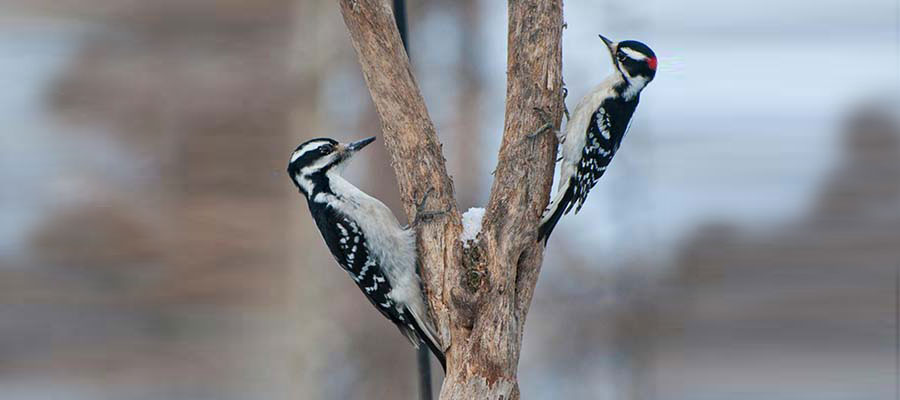
Woodpeckers are fascinating birds! These handsome birds are fun to watch as they hitch up tree trunks and peck into wood. We can also appreciate woodpeckers at feeders, but when they hammer on our siding or roofs… maybe not as much!
Why do woodpeckers peck into wood? Why do these neat birds insist on hammering the sides of some houses and other structures?
See this article for answers and much more about the pecking habits of woodpeckers!
On this page
Why Do Woodpeckers Peck On Wood?
Woodpeckers seem to spend a lot of their time pecking into wood, but why do they do it? Although it might seem like these busy birds peck on wood for fun, they are working on much more serious matters.
First and foremost, most woodpeckers peck to find food. If they have the chance, most woodpecker species will pick bugs and other bits of food from branches. However, the majority of their food hides beneath bark and in the tree itself.
Woodpeckers also peck into wood to excavate nesting sites. No woodpecker makes cup nests like many other birds do. Instead, they work to make a suitable hole where they can lay their eggs.
The third main reason why woodpeckers peck into wood is for territorial purposes. While woodpeckers do give loud calls, they also quickly peck or “drum” on wood to both find a mate and tell other woodpeckers to stay away.
Food
Woodpeckers peck into wood to get at insects. Although most species peck into wood to some degree, many feed on different types of bugs. For example, Downy Woodpeckers use their small beaks to tap into thin stems and bark.
Related: What do woodpeckers eat?
After making small holes, they use their tongues to extract small larvae and insects.
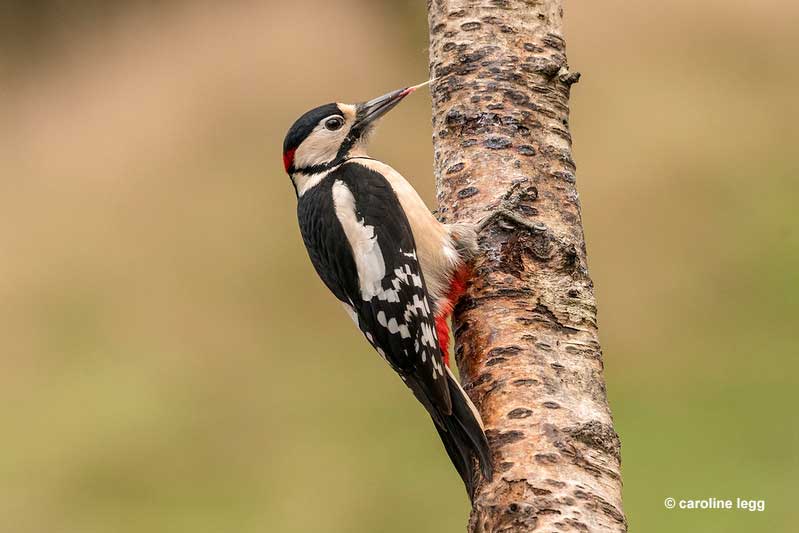
The Hairy Woodpecker might look similar but uses its longer beak to peck deeper into big, mature trees. It’s also looking for insects but eats larger ones along with more beetle larvae.
In general, grubs are an important food source for most woodpeckers. Long-horned beetle species and other types of beetles that burrow into both dead and live wood act as important woodpecker food just about everywhere.
The huge Pileated Woodpecker also eats big beetle larvae as well as lots of carpenter ants. It finds them by whacking off pieces of bark and pecking into decayed logs.
Nests
Woodpeckers only nest in holes that they excavate. Most nest in dead branches or dead snags and can peck out a nesting hole high overhead or just 15 feet above the ground.
Although most make a new nest cavity every breeding season, the Red-headed Woodpecker and the Lewis’s Woodpecker can reuse old nests.
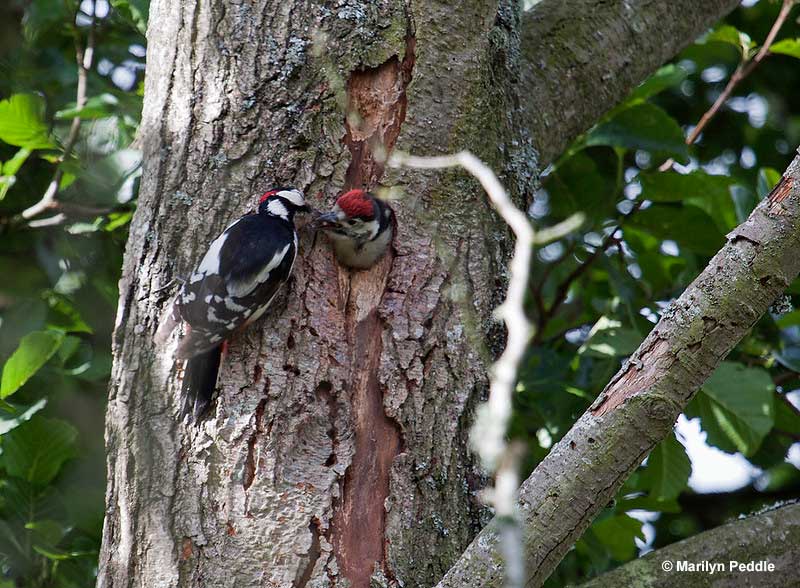
These beautiful birds may reuse old nests because, compared to other woodpeckers, they live in more open areas with fewer trees.
Other woodpeckers hack out new nests each year, in all sorts of trees. Many male and female woodpeckers have separate territories but when nesting, both sexes work together to create the nesting hole. They then continue to peck into the wood to make a cavity that extends downward for a foot or more!
Pileated Woodpeckers can take six weeks to make their large nesting cavities. These nests are excavated from big dead snags and can have more than one entrance!
Communication
All woodpeckers quickly and repeatedly peck on wood and other structures. This rapid pecking is known as “drumming” and acts as the woodpecker’s song. They drum for the same reasons that other birds sing; to attract a mate and show where they live.
In the case of woodpeckers, both males and females drum. They drum to locate each other and then decide which birds to choose for a mate.
Since woodpeckers want their drumming to be heard as loud and far as possible, they only drum on dead wood and other spots that help broadcast the sound. Such other spots can include siding and even metal roofs!
Although we can hear drumming at any time of day, like birds that sing, most woodpeckers also drum in the early morning and late afternoon.
Each species also has its own drumming frequency with the drumming of some woodpecker species (such as the Yellow-bellied Sapsucker) being pretty easy to recognize.
Food storage
Woodpeckers can also peck into wood to store their food. Acorn Woodpeckers are famous for storing hundreds, even thousands of acorns. Families of this handsome, clownish woodpecker make dozens of small holes in a tree or other suitable wooden surface and fill each one with an acorn.
Wherever Acorn Woodpeckers live, such granary trees are a common sight and pretty easy to recognize! They can take the form of trees dotted with thousands of acorns.
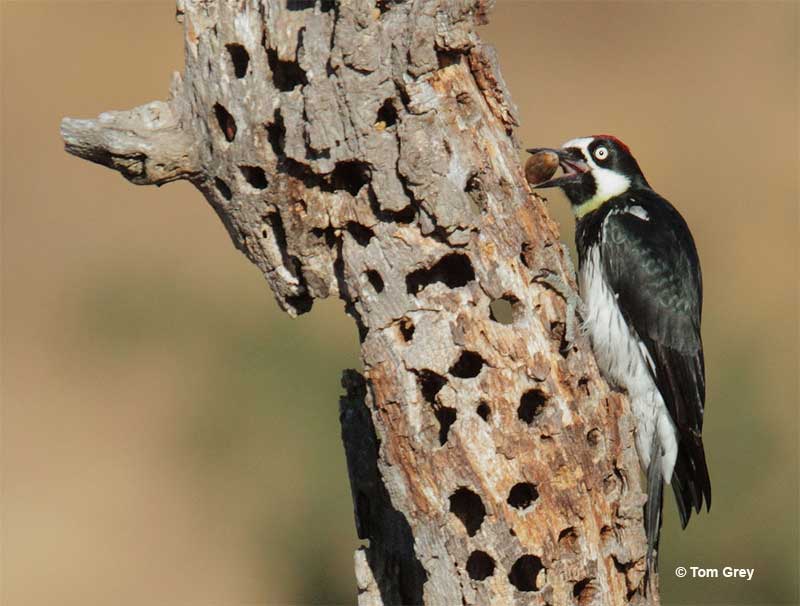
Some other woodpeckers also store food in holes but are much less conspicuous about it. Both Red-headed and Red-bellied Woodpeckers hide extra seeds and nuts in crevices and other spots in trees, and can also cover them with pieces of bark!
Like the Acorn Woodpecker, these woodpeckers cache food so they can have something to eat in case natural food sources become scarce.
However, most other woodpeckers look for fresh food and find it by pecking into branches and trunks.
How To Get Rid Of Woodpeckers?
Woodpeckers are such beautiful and interesting birds! Fun to watch, these backyard birds also play important roles in local ecosystems. However, there are certain times when woodpeckers aren’t quite so welcome.
While we love seeing them at feeders, we don’t really want woodpeckers pecking into our houses.
They can peck into wooden beams and other places but especially love to make holes in grooved plywood siding.
I love woodpeckers but when they start doing this, I don’t have any choice but to try and drive them away. Otherwise, not only do they damage the house, they also make holes that can attract carpenter ants and other harmful insects.
Luckily, most woodpeckers only peck into a house in late winter and spring. They can also peck into siding in other months, but this is when they drum on wood to find a mate.
To deter woodpeckers from pecking on the house, there are a few things you can try. One possibility is hanging CDs, reflective tape, or holographic mylar tape. Woodpeckers can be wary of these shiny objects especially if they see their own reflection. This fix works even better by complementing it with a pair of realistic owl statues, especially ones with reflective eyes!
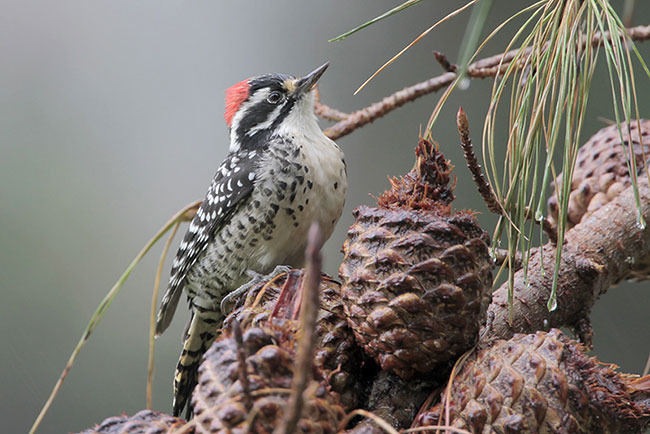
Although they can be a nuisance, woodpeckers are still marvelous creatures, so enjoy their presence!
Benefits of Woodpeckers & Other Fun Facts
- Woodpeckers create homes for lots of birds and animals. Woodpecker holes provide vital shelter and nests for ducks, chickadees, nuthatches, flying squirrels, and many other species!
- Woodpeckers play other, very important roles in forest ecosystems. Their pecking helps provide habitats for important fungi and many other species that require dead or decaying trees.
- Pecking woodpeckers eliminate large numbers of insect pests. They eat thousands of carpenter ants, beetles, and other bugs that harm trees and can damage wooden homes.
- Northern Flickers devour thousands of ants that could otherwise increase and have much larger ant nests. Such huge numbers of ants would have a negative effect on local ecosystems.
- When woodpeckers eat berries, they help trees grow by passing the seeds in their droppings.
- A drumming woodpecker can peck as fast as 20 times per second!
- Last but not least, it’s fun to watch woodpeckers! Most species have striking plumage and lend a unique touch to the backyard and other favorite birding spots.
Frequently Asked Questions
How do woodpeckers know where to peck?
Woodpeckers know where to peck by carefully listening for insects underneath bark and in tree trunks. They also look for small holes and other signs of insects.
Do woodpeckers kill trees?
Woodpeckers don’t usually kill trees. However, trees can be harmed by fungus, disease, and insects that use woodpecker holes.
How do woodpeckers not get concussions?
Woodpeckers do not get concussions by having adaptations that cushion their skulls. They have strong and thick neck muscles, spongy bone on the front part of their skull, and a long tongue that wraps around and helps to further protect their skulls from impacts.

